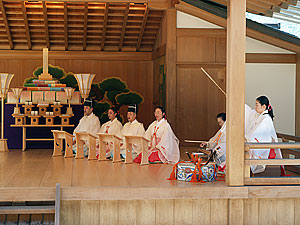“Something Great”
This genetics pioneer, a friend of Oomoto, offers a clue to the mystery of life
By Bill Roberts
Dr. Kazuo Murakami, an award-winning scientist and a friend of Oomoto, has spent a lifetime seeking certainty in his field of biochemistry, but is comfortable with ambiguity in general. Consider his conclusion that all life must be the product of what he calls “Something Great” – which he prefers to leave undefined.
Based on more than 25 years in gene research, including his participation in the Japanese-led effort to break the genetic code of rice, Murakami believes there is some grand design in the world. Species may have evolved in accord with the theory of natural selection, but Murakami notes that Charles Darwin did not know about genes. Based on his research, Murakami does not believe genetic code happened by chance.
“My simple definition of Something Great is the ‘original parents’ of all living organisms -- whatever that is,” he explained. “But we don’t know exactly what that is.”
During a speaking tour in the United States last year, Murakami was often asked, “What is the difference between God and Something Great?”
To which he would reply: “Something Great might be God, but it might not be. We don’t know. But it is Something Great.”
The question askers didn’t know what to say in response, he recalled.
On that U.S. tour, Murakami was promoting “The Divine Code of Life: Awaken Your Genes and Discover Your Hidden Talents” (Beyond Words Publishing, Inc., Hillsboro, Ore., 2006), the English version of a book he published in Japan more than ten years ago. Still in print, the Japanese version has sold more than 200,000 copies, he said.
Murakami attributed its success to what he sees as a growing sense among Japanese that, despite vast economic and technological advances, something is missing from their lives. Like many Americans, they have a spiritual thirst and seek some deeper meaning in life. For a man of science – and perhaps for many of us –Something Great might be as precise as the deeper meaning gets.
In America, Murakami would be considered an adherent of “intelligent design,” the claim that some features of the world, including those of humans, are best explained by an intelligent cause, not by evolutionary processes such as natural selection. Most American proponents of intelligent design believe the designer is God. Murakami is not that certain; hence, his reluctance to define Something Great as anything other than Something Great.
He does want people to understand that Something Great is something wonderful. This is the theme of a more recent book, “The World began from a single life: A Gift From “Something Great.” The book was a collaboration between Murakami and Yoh Shomei, one of Japan’s best known artists. Published in 2004, the text appears in three languages: Japanese, English and Esperanto, an international language invented 120 years ago and promoted by Oomoto.
Beautifully illustrated, this book spells out Murakami’s idea about Something Great, and urges us to appreciate it, be grateful for it – whatever it is – and be happy as a result.
I had wanted to interview Murakami since the first time I heard him speak at Oomoto’s 2002 World Religious Forum, held in Kyoto in November of that year. He explained that we now know that the genetic code of all living things has a similar form, and that this could only have been created by Something Great. All life—human, animal, plant and individual cells—is essentially the same and thus deserving of respect, he suggested.
With all the world’s environmental problems, including global warming and the depletion of resources, it seemed to me that Murakami offered a message for everyone when he talked about respect for all life.
To live in harmony with nature is one of the tenants of Oomoto (which means “the Great Origin”) specifically, and of Shinto faith more generally. In the West, it is a way of thinking more congruent with Native American beliefs than with monotheistic religion. It is also a central belief of Tenrikyo, the Shinto sect to which Murakami belongs.
Founded in 1838, Tenrikyo was the first of the so-called “New Religions” in Japan that started before the Meiji era (1867-1912). Like Oomoto, Tenrikyo was founded by a woman, and has its roots in ancient Shinto beliefs. It is much larger than Oomoto, and one of the largest of the New Religions, with a worldwide membership.
Murakami grew up in a Tenrikyo family, his father a missionary for the sect. He was educated in Tenrikyo-run schools through high school before going to Kyoto University, where he majored in agricultural biochemistry and completed his doctorate.
He later had a post-doctoral fellowship at the Oregon Medical University in Portland, and spent several years as an assistant professor, doing enzyme research, at Vanderbilt University School of Medicine in Nashville. Between 1963 and 1975, he spent a total of nine years in the U.S.
After I heard him speak in 2002, I occasionally ran into Murakami, but it would be nearly five years, in August 2007, when we finally had a chance to meet and talk. We spoke in English over dinner at a restaurant in Ayabe, home of Oomoto’s spiritual headquarters. He was in Ayabe to talk about Something Great at an interfaith conference.
Murakami spends as many as 120 days a year giving lectures, and is often asked to talk about his blend of science and religion with religious leaders. Oomoto first invited him to speak ten years ago, soon after the publication of “The Divine Code of Life.”
He has been a prolific writer of scientific papers and more popular works. He won the international Max Planck Research Award in 1990 and the Japan Academy Prize in 1996.
Now 71 years old, this emeritus professor at Tsukuba University is anything but retired. Besides lecturing, he currently heads the Foundation for Advancement of International Science Bio Laboratory, a recognized authority on biogenetics.
Murakami is trying to establishing a connection between human genes and laughter.
He’s been encouraged in this endeavor by no less than Tenzin Gyatso, the Dalai Lama of Tibet, during a conference in India to examine the relationship between science and Buddhism. Murakami has met the Dalai Lama on four occasions, including in November 2006 at the Hiroshima Peace Summit, where the professor served as master of ceremonies for the opening session which featured addressed by three Nobel Peace Prize laureates – the Dalai Lama, Archbishop Desmond Tutu of South Africa and Northern Ireland peace activist Betty Williams.
Murakami, who likes to tell ribald jokes, has already done research that suggests laughter can be used to control genes and bring down blood pressure. Now he wants to know why.
“I am most interested in the relationship of the mind to human genes,” he told me. “I also want to study the relationship between genes and prayer. But that will be very difficult.”

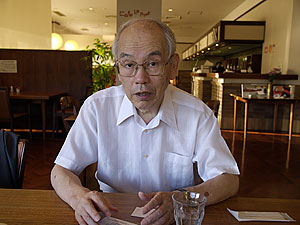
At 71, Murakami is still active in genetic research.
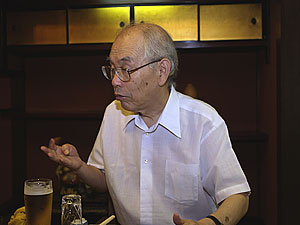
“Something Great” is something he declines to define except in general terms.
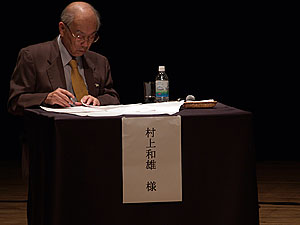
Murakami presides at the opening session of the Hiroshima Peace Summit in November 2006.
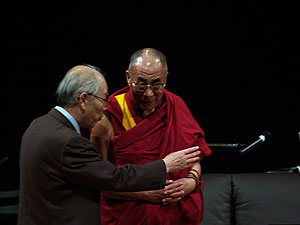
Murakami greets the Dalai Lama at the Hiroshima Peace Summit.
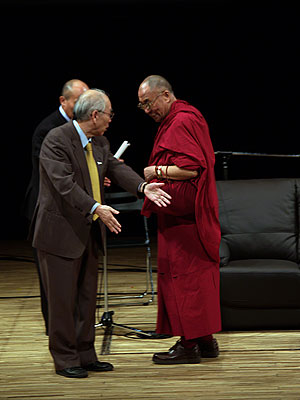
Giving stage directions.
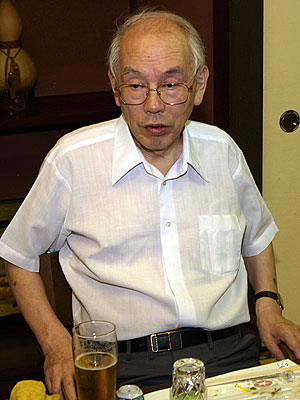
New Contents Thu, May 20, 2010
- Oomoto participates in Sant’Egidio conference : Dialogue among religions and cultures : On divided island nation of Cyprus By Bill Roberts
- Photo Album : Portraits of three branches: Shoko, Tanegashima and Aomori By Bill Roberts
- Oomoto FAQ
- A Letter from Oomoto : Of mountains and myths By Bill Roberts
- Polyglot poem festival The Utamasturi is going international — what’s next? By Bill Roberts
- Ethics education program captures the spirit of Bankyo Dokon By Bill Roberts
- A Letter from Oomoto : A year’s worth of adventure in a summer of branch visits By Bill Roberts
- In Kumamoto, it’s all about water – and fire By Bill Roberts
- A speech by Nevada Taylor at the Kii Branch in Wakayama Prefecture on April 13, 2008.:An Encounter With Oomoto Through Aikido
- Utamatsuri, Poem Festival, in Tokyo(on April 17, 2008)
- A speech by Neil Ryan Walsh at the Kobe branch on Mar. 9th, 2008.:Planting the Seeds of the Soul
- Meeting with the Fifth Spiritual Leader of Oomoto, Madame Kurenai Deguchi by Neil Ryan Walsh
- A speech by Neil Ryan Walsh at the Nagoya branch on Feb. 17th, 2008.:The Japanese Arts beyond National Boundaries
- To the Oomoto branch in Nagoya: City of Eel and Toyota by Neil Ryan Walsh
- A Speech by Nissim Ben Shitrit, Ambassador of Israel on the occasion of the Oomoto Setsubun Grand Festival in Ayabe February 3rd, 2008 : Japan and Israel : Two Lands Balancing the Needs of Traditional Culture and Modern Life. r
- A permanent memorial to Onisaburo (A Speech at the Autumn Grand Festival , November 6, 2007 : )By James Parks Morton, Founder and Chair, Emeritus of The Interfaith Center of New York
- Israel, Palestine and the Power of Poetry(Oomoto believes small efforts can have lasting ripple effects on people and peace)By Bill Roberts
- “Something Great”(This genetics pioneer, a friend of Oomoto, offers a clue to the mystery of life)By Bill Roberts
- Kamishima Cleanup (Harima branch members regularly visit this sacred island to keep the shrine tidy)By Bill Roberts
- Kyotaro Deguchi was one of six recipients of the 2007 James Parks Morton Interfaith Award
What is Oomoto?
- What is Oomoto?
- Spirtual Centers
- Founders and Spiritual Leaders
- History
- Organization and activities
- Teachings and scriptures
- Art Works of Founders and Leaders
Opinions[Archive]
- Statement of regret for the outbreak of war against Iraq (March 20,2003)
- Jinrui Aizenkai dispatched the "Urgent Appeal for a World (Global) Crisis" on March 14.
Grappling with Bioethics[Archive]
- Oomoto’s support for abolishing the death penalty (12, June 2003)
- The Oomoto Foundation protests any birth of a human clone baby. (5, January 2003)
- OOMOTO'S VIEW REGARDING JAPAN’S PERMITION TO THE RESERCH OF HUMAN EMBRYONIC STEM CELLS (ES cells)(12, June 2000)
Vistor’s Review[Archive]
- A speech by Bill Roberts at the Oomoto branch in Hiroshima after its monthly service on March 18, 2007:Encounters with war and peace
- How Bankyo Dokon changed one life by Linda Macphee
- A speech by Bill Roberts at the Hokuriku (Kanazawa) branch on Dec. 3, 2006:Ritual and myth -an encounter with ‘divine madness’
- A speech by Bill Roberts at the Himeji Cultural Center on Feb. 25, 2007:Mesmerized by the Japanese Arts
- A speech by Bill Roberts at the Kobe branch on Feb. 11th, 2007.:There are just human tears and human joy
- A Speech on the occasion of the Oomoto Setsubun Grand Festival in Ayabe February 3rd, 2007 : Egypt's role in Middle East peace
- Keynote Speech for the 28th World Federation Japanese Religionists Conference for World Peace in Tokyo (at Kokugakuin University, Novermber 29, 2006):Vision for Peace in the Middle East By Dr. Munther S. Dajani, Professor Dean, Faculty of Arts, Al Quds University, Jerusalem
- A speech to the Kyoto branch:Spiritual adventures in researching Oomoto leaders
- A Speech at The Oomoto Foundation on Monday, November 6, 2006 : Jordan's role in Middle East By Samir Nouri, Ambassador of the Hashemite Kingdom of Jordan
- A letter from Oomoto:The Young People of Tottori
- A speech by Bill Roberts on the occasion of the dedication ceremony for the new shrine of Tottori Branch By Bill Roberts Oct. 8, 2006
- A speech by Bill Roberts at the Oomoto branch in Hiroshima after its monthly service on March 18, 2007:Encounters with war and peace
- How Bankyo Dokon changed one life by Linda Macphee
- A speech at Setsubun : A Portrait of Oomoto By Bill Roberts Feb. 3, 2006
- New Publication ! By Bill Roberts Feb. 3, 2006 A Portrait of Oomoto
you can read this book in html => http://www.jinruiaizenkai.jp/English/en-kolumno/en-bill/en-sugao/billbook1en.html
E-mail below to order brobert1@ix.netcom.com
Current Topics
- Prayer Offering and World Religious Forum II
- Living the art of dialogue
- Kyotaro Deguchi was one of six recipients of the 2007 James Parks Morton Interfaith Award
Books
Online Books
- Divine Signposts by Onisaburo DEGUCHI
- The Creation of Meaning by Hidemaru Deguchi
- Bankyo Dokon(Seventy years of Inter-Religious Activity at Oomoto)
- Nao Deguchi — A Biography of the Foundress of Oomoto
- The Great Onisaburo Deguchi published by Aiki News
- Bankyo Dokon Seventy Years of Inter-Religious Activity at Oomoto
- Insearch of Meaning
- Nao Deguchi A Biography of the Foundress of Oomoto
- A Portrait of Oomoto By Bill Roberts
Oomoto international Archive
- The History of Oomoto (Jan.– Mar. 1980 — Apr.– Jun. 1982)
- The Ancestors; Friends or Foes? (Apr.– Jun. 1987)
- Tsukinamisai; The Sabbath of Shinto (Jan.– Jun. 1983)
- The Poem Festival at Oomoto; An Ancient Rite Lives Again (Oct.– Dec. 1981)
- Purification of the Universe ; Oomoto's Setsubun Festival (Apr.– Jun. 1981)
Links
Flowers at Ten'on-kyo & Baisho-en (photographs)
Contact
All rights reserved : the Oomoto Foundation Produced by the Netinformational Commission
Since : Mar. 7.1998 Last Update : Thu, May 20, 2010
E-mail : webmaster@oomoto.or.jp
Top Page Nihongo Esperanto Português Roomazi



